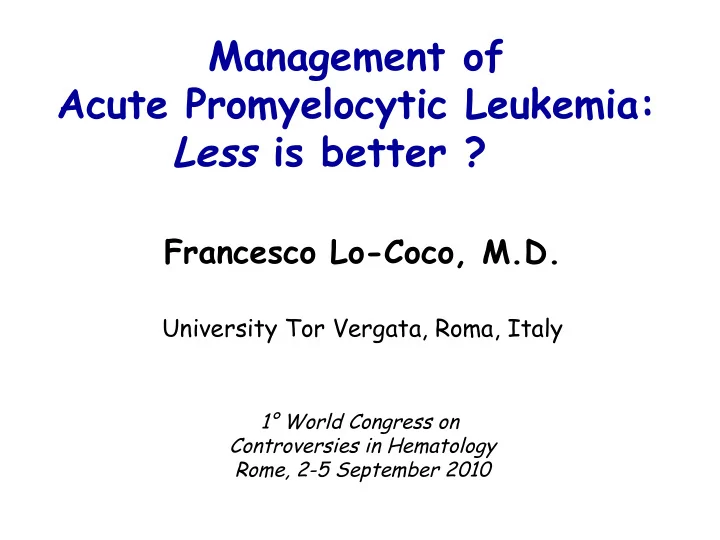

Management of Acute Promyelocytic Leukemia: Less is better ? Francesco Lo-Coco, M.D. University Tor Vergata, Roma, Italy 1° World Congress on Controversies in Hematology Rome, 2-5 September 2010
GIMEMA trials in newly diagnosed APL • 77-81: DNR • 82-88: IDA • 89-93: IDA vs IDA+AraC • 93-99: AIDA 0493 • 00-05: AIDA 2000 • 06-10: AIDA vs A 2 O 3 +RA
EFS by type of chemo Avvisati et al. Blood 2002
The hazards of chemo Induction death Death in CR Cardiotoxicity Second tumors Fertility Other long-term sequaele
Causes of induction deaths with chemo + ATRA Hemorrhage Infection Other PETHEMA 5% 2-3% 1% GIMEMA 3% 1-2% 1% French-Belgian-Swiss 3% 2-3% 0.5-1% MRC 5% 2% 1% US-Intergroup 6-7% 1-6% 1-2%
PETHEMA LPA99 Trial Mortality in remission (by Sanz) 23.1% 5.4% 2.3% 0.9% Sanz et al, 2010
Post-Induction toxicity in the AIDA 2000 420 in CR after induction 377/420 (90%) 43 (10%) off-study for: evaluable after consolidation 17 toxicity (11 deaths) 14 missing data 7 major protocol violation 362/377 (96%) tested 3 lost to follow-up for RT-PCR 1 refusal post-consolidation 1 other 358/362 (99%) PCR-negative proceeded to maintenance Lo-Coco et al, Blood 2010
AIDA 0493 drop-outs during consolidation Consolidation Courses CR 1st 2nd 3rd (n 761) (747) (728) (681) Refusal 2 - - 1 Relapse - 3 2 - Toxicity 6 13 29 - Violation - 3 9 2 Other causes 3 6 9 6 Lost to FU - 1 - 2 747 728 681 664 Remaining Pts
PETHEMA LPA99 Trial Other post-remission events (Sanz’s data) 37 37 37 37 CNS CNS 14 14 13 13 7 7 2 2 ** ** ** Montesinos ** Montesinos et al. et al. , J Clin Oncol 2010 , J Clin Oncol 2010
Cardiac function in long-term survivors after the AIDA regimen Features Pts Controls (n=34) (n=34) Median Age (years) 48.5 45 (range) (27 – 60) (24 - 62) Sex Male 16 14 Female 19 20 Cardiovascular disease at diagnosis None -- Cardiovascular risk factors 6/34 6/34 Hypertension (at diagnosis of APL) 18/34 -- Hypertension at time of present evaluation 10/34 14/34 Smoker 6/34 2/34 Hypercholesterol 1/34 0/34 Diabetes mellitus 10/34 7/34 Family history of CHD Median Follow-up from stop therapy (yrs.) 7 -- (range) (3-10) Cimino et al., submitted
ECHO parameters recorded in pts and controls Echocardiographic Pts Controls p parameters (n = 34) (n = 34) Mean EF (SD) 56.53 (4.40) 58.58 (4.66) 0.013 (%) Mean LAV (SD) 52.24 (17.16) 31.41 (10.36) < 0.0001 (ml) Mean E/A ratio (SD) 1.04 (0.31) 1.38 (0.21) < 0.0001 SWM abnormalities: 11(32%)* 0 < 0.0001 hypokinesis 0 0 akynesis 0 0 dyskinesis Diastolic Disfuction: 18(52%) 0 < 0.0001 Mild 0 0 Moderate 0 0 Severe All recorded differences between pts and controls were sub-clinical Cimino et al., submitted
Active compounds in APL Hem. CR Mol. CR Long-term CR Anthracyclines + + + Retinoids + - (*) - (*) Arsenic Trioxide + + ? Mylotarg (GO) + + ? (*) Mol and long-term CR reported with lipo-ATRA
Reasons why chemo might be unnecessary • Liposomal ATRA monotherapy curative in 12/28 pts with WBC < 10,000 • ATO induces mol. CR in 80% rAPL • ATO + ATRA superior to ATO or ATRA alone • Effectiveness of GO+ATRA in untreated and mol-relapsed APL Estey, Blood 2006; Soignet, JCO 2001; Shen, PNAS 2004; Lo-Coco, Blood 2004
Molecular response by cycle with single agent ATO for rAPL 100 Proportion Negative 50 78% 51% 0 Baseline Induction Consolidation Soignet et al. JCO 2001
ATO as single agent for newly diagnosed APL Mathews et al. Blood 2006
ATO + ATRA ± GO for newly diagnosed APL Estey, Blood 2006
NCI-CALGB study in newly diagnosed APL • 582 patients, randomly assigned to: Standard Rx with ATRA+CHT Standard Rx + ATO 2 cycles after CR • 3 yrs DFS: 77% in the ATO arm, vs 59% • 3 yrs OS: 86% in the ATO arm, vs 77% Powell et al, Blood 2010
EFS in APL trials at MDACC By courtesy of E. Estey
Problems with ATO “no chemo” trials Few numbers & limited follow-up Only historical controls vs. chemo available to date Duration of ATO unclear (Maintenance ? How long ?) Long-term toxicity of ATO unknown
GIMEMA/SAL/AMLSG APL 0406 study AIDA 2000 (anthracycline-based consolidation) Low-risk R (wbc<10.000) ATRA + ATO (MDACC approach) High-risk AIDA 2000 (including AraC for (wbc >10.000) consolidation)
GIMEMA/SAL/AMLSG APL 0496: Study End-points Primary EFS at 2 yrs Secondary CR rate after induction OS rate at 2 yrs CIR rate at 2 yrs Toxicity episodes Molecular CR after 3rd cons Kinetics of PML/RARa Hospitalisation days during Rx Quality of life
Conclusive remarks Need to discriminate high vs. low-risk pts PCR-monitoring carried out in highly experienced labs may serve as a “safety guide” in experimental (e.g. no chemo) trials Results of ongoing R trials comparing “no chemo” vs. standard AIDA (Gimema, MRC) soon available
Recommend
More recommend